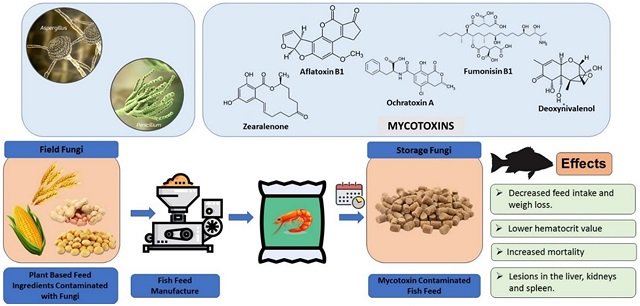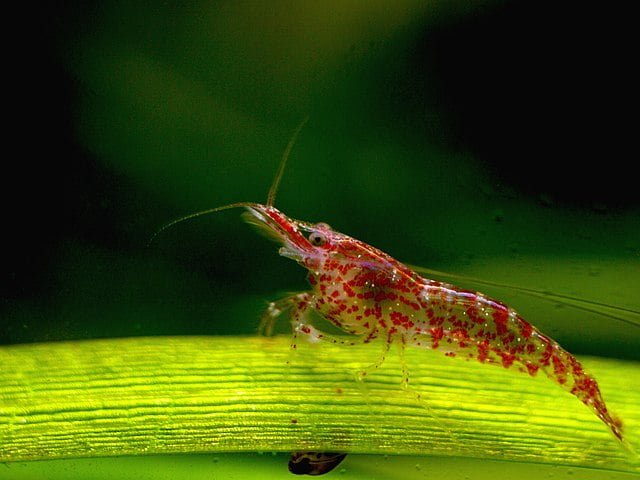
Mycotoxin contamination in fish and shrimp feed is a challenge that the aquaculture industry must face. A recent comprehensive study, “Mapping global research on mycotoxins in aquafeed from scientometric and critical perspectives”, has shed light on the extent of this problem, research trends, and knowledge gaps that still need to be addressed.
The study, published by researchers from the International Centre of Insect Physiology and Ecology (icipe), Tamil Nadu Dr. J. Jayalalithaa Fisheries University, the Kenya Marine and Fisheries Research Institute (KMFRI), and WorldFish, breaks down the key findings of mycotoxin contamination in aquafeed, offering an accessible perspective for all stakeholders in the aquaculture sector.
What are mycotoxins and why are they a threat in aquaculture?
- 1 What are mycotoxins and why are they a threat in aquaculture?
- 2 A global map of research on mycotoxins in aquafeed
- 3 Where and which mycotoxins are most frequent?
- 4 The impact of mycotoxins: a double detriment to fish and humans
- 5 Regulations and detection methods: a complex landscape
- 6 Research gaps and the way forward: challenges and opportunities
- 7 Conclusion
- 8 Entradas relacionadas:
Mycotoxins are toxic compounds naturally produced by certain types of fungi (molds). When animals or humans ingest these compounds, they can suffer from a condition called mycotoxicosis, which can cause illness and even death. Toxin-producing fungi can contaminate crops in the field (field fungi such as Alternaria and Fusarium spp.) or during post-harvest storage (storage fungi such as Aspergillus spp. and Penicillium spp.). Factors such as high temperature, high humidity, and poor transportation and storage practices favor the production of these toxins.
It is important to note that the mere presence of these fungi in feed ingredients does not necessarily imply mycotoxin contamination. However, raw materials commonly used in the manufacture of animal feed, such as corn, peanuts, and cotton, are susceptible to fungal invasion. Scientists have identified between 300 and 400 types of mycotoxins, with aflatoxins (especially AFB1, B2, G1, G2) and fumonisins (FB1, FB2, and FB3) being the most significant due to their impact. These substances are generally chemically and thermally stable, meaning they can survive feed storage and production processes.
The contamination of aquafeed not only decreases its nutritional value but also represents a global challenge for aquaculturists. The FAO estimates that up to 25% of the world’s food crops and a significant proportion of the world’s animal feedstuffs are contaminated by mycotoxins. Climate change, with rising global temperatures and changes in precipitation patterns, could exacerbate this problem by creating more favorable conditions for the growth of toxigenic fungi and mycotoxin production.
A global map of research on mycotoxins in aquafeed
The study published in the journal Frontiers in Sustainable Food Systems employed a scientometric approach, using tools such as VOSviewer and biblioshiny, to map research trends, collaborations, and themes in publications on mycotoxins in aquafeed between 1992 and 2023, obtained from the Web of Science database.
Scientists identified 181 publications, with the participation of 938 researchers from 49 countries. Brazil was the leading country in the number of publications (25), while the journal Toxins published the most articles on the subject (23). Aflatoxins, particularly aflatoxin B1 (AFB1), were the most reported mycotoxins, followed by fumonisins, deoxynivalenol (DON), and zearalenone.
The research also highlights that scientific activity in this field has increased slowly, with a peak in publications in 2020 (25 articles). Most of the works were original research articles (152), followed by review articles (18).
Stay Always Informed
Join our communities to instantly receive the most important news, reports, and analysis from the aquaculture industry.
Where and which mycotoxins are most frequent?
Mycotoxin occurrence is notably higher in tropical regions. In particular:
- East African countries: A wide range has been reported, including aflatoxins, fumonisins, deoxynivalenol, acetyldeoxynivalenol, ochratoxin A, roquefortine C, alternariol, T-2 toxin, zearalenone, and zivalenol. Specific studies in Kenya, Tanzania, Rwanda, and Uganda found that DON, aflatoxins, and fumonisins were the most prevalent. Worrying levels of AFB1 have been detected in Kenya and Uganda.
- Southeast Asian countries: Aflatoxins, fumonisins, deoxynivalenol, zearalenone, and ochratoxin A predominate.
- European countries: Aflatoxins, fumonisins, deoxynivalenol, zearalenone, and ochratoxin A have also been found. Climatic conditions in these tropical and subtropical zones exacerbate fungal growth and mycotoxin production. According to the study results, the increased use of plant-based ingredients in aquafeed (such as soybean meal, cottonseed meal, corn gluten meal, etc.) as substitutes for fishmeal, although more economical, has increased the risk of fish exposure to these toxins. A relevant fact is that fish feed made on farms or locally tends to have higher concentrations of mycotoxins compared to commercial feed, especially in developing countries. This could explain why contamination is more frequent in these regions.
The impact of mycotoxins: a double detriment to fish and humans
Effects on fish
Mycotoxins can induce a variety of disorders in fish, from cellular and organic alterations to morphological effects and, in severe cases, mortality, resulting in significant economic losses. Some specific effects include:
- Aflatoxins: Can cause liver cancer in rainbow trout and decrease immunity in various fish species.
- Fumonisins: Cause reduced hematocrit and liver alterations in channel catfish and Nile tilapia.
- Ochratoxin A: Causes hemorrhages, fin erosion, kidney and gill congestion, and liver and kidney lesions in various species.
- Trichothecenes (such as DON): Can cause gastrointestinal and liver hemorrhaging, anemia, decreased metabolism, and liver lesions in rainbow trout.
- Zearalenone: Has been associated with growth alterations, feminization, and decreased reproductive performance in zebrafish, and immune system modulation in rainbow trout. In general, mycotoxins damage organs, impair the immune system, reduce weight gain, and cause metabolic alterations that can lead to cancer and increased mortality in fish.
Effects on humans
The main route of human exposure to mycotoxins is the ingestion of contaminated food, with the burden of dietary exposure being particularly high in developing countries. Humans can be indirectly exposed by consuming fish that have accumulated aflatoxin residues.
- Aflatoxin B1 (AFB1): Is recognized as a group 1 carcinogen by the International Agency for Research on Cancer (IARC), mainly affecting the liver.
- Fumonisins: Fumonisin B1 is a group 2B carcinogen and has been associated with a higher incidence of esophageal and liver cancer, as well as possible risks of neural tube defects in offspring if exposure occurs during pregnancy.
- Ochratoxin A (OTA): Considered a group 2B carcinogen, it may be involved in the development of liver cancer, urinary tract tumors, and testicular cancer.
- Deoxynivalenol (DON): Although its effects are generally gastrointestinal, it can be a health concern in children and, at high exposure, also in adolescents and adults.
- Zearalenone: Classified as a xenoestrogen, it can alter hormonal balance and has been linked to reproductive system disorders and certain types of cancer.
Regulations and detection methods: a complex landscape
The severity of mycotoxin contamination has led international bodies such as the FAO, UNEP, and WHO to get involved in controlling mycotoxins globally. More than 100 countries have specific regulations for mycotoxins, although there is a lack of harmonization, even among trade partners. The CODEX Alimentarius Commission plays a crucial role in developing standards and codes of practice to protect consumer health and promote ethical food trade practices.
European Union regulations are often a benchmark. For example, the maximum permissible limits for total aflatoxin are 20 µg/kg according to the US FDA and 5 µg/kg according to the WHO56, while for fumonisin B1+B2, the EC sets 10 µg/kg for fish. For ochratoxin A, the EC limit is 5 µg/kg, and for deoxynivalenol and zearalenone, the limits are 5,000 µg/kg respectively according to EC. It is essential to consult the specific regulations for each case.
Due to the structural diversity of mycotoxins, there is no single standard technique to detect them all. Chromatographic methods (such as TLC and HPLC), immunological methods (such as ELISA), and advanced techniques such as ultra-high-performance liquid chromatography coupled with mass spectrometry (LC-MS/MS) are used, which allows for the simultaneous identification of multiple mycotoxins.
Research gaps and the way forward: challenges and opportunities
Despite progress, the study identifies several important research gaps:
- Lack of regional specificity: A more detailed examination of the unique vulnerabilities of specific regions, especially in developing countries, is needed.
- Species-specific research: There is limited knowledge about the tolerance and sensitivity of different aquaculture species to various mycotoxins.
- Inconsistent regulations: A deeper analysis of the impact of regulatory variations on aquafeed trade and local aquaculture industries is necessary.
- Impact of climate change: The role of climate change in exacerbating mycotoxin contamination has not been sufficiently addressed.
- Practical mitigation strategies: Mitigation strategies, such as detoxification methods or the use of alternative feed ingredients, are discussed little. In this regard, other studies have reported the use of biological control, and the use of bentonite clay. For the future, research should focus on:
- Establishing species-specific mycotoxin tolerance.
- Conducting deeper regional studies, especially in developing countries.
- Harmonizing global regulations on permissible mycotoxin levels, leveraging frameworks like the Codex Alimentarius.
- Exploring the influence of climate change on the prevalence and dynamics of contamination.
- Developing and evaluating practical and cost-effective mitigation strategies, such as the use of mycotoxin binders (bentonite, activated carbon) or biological detoxification.
- Fostering interdisciplinary research networks.
Conclusion
Global research on mycotoxins in aquafeed has grown, revealing that contamination is a common and worldwide problem, with a higher prevalence in warm regions and developing countries that often lack strict regulations and effective surveillance. The detrimental effects of these toxins on both fish and human health underscore the urgent need to continue research, improve regulations, and develop effective mitigation strategies. Addressing these challenges is crucial to safeguarding aquaculture productivity, consumer health, and the long-term sustainability of the sector.
Reference (open access)
Meenakshisundaram, M., Shanmugam, S., Mboya, J. B., Sugantham, F., Obiero, K., Munguti, J., Ekesi, S., Subramanian, S., Chia, S. Y., Beesigamukama, D., Yossa, R., & Tanga, C. M. (2025). Mapping global research on mycotoxins in aquafeed from scientometric and critical perspectives. Frontiers in Sustainable Food Systems, 9, 1609489. https://doi.org/10.3389/fsufs.2025.1609489
Editor at the digital magazine AquaHoy. He holds a degree in Aquaculture Biology from the National University of Santa (UNS) and a Master’s degree in Science and Innovation Management from the Polytechnic University of Valencia, with postgraduate diplomas in Business Innovation and Innovation Management. He possesses extensive experience in the aquaculture and fisheries sector, having led the Fisheries Innovation Unit of the National Program for Innovation in Fisheries and Aquaculture (PNIPA). He has served as a senior consultant in technology watch, an innovation project formulator and advisor, and a lecturer at UNS. He is a member of the Peruvian College of Biologists and was recognized by the World Aquaculture Society (WAS) in 2016 for his contribution to aquaculture.




